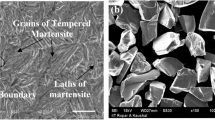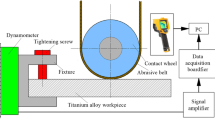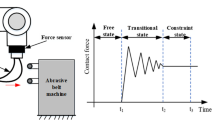Abstract
Belt grinding is widely used as the final step in the fabrication of fatigue-resistant surfaces of nickel-based superalloy components, and fatigue life after grinding is one of the most concerning issues. However, the response mechanism of fatigue life under different grinding parameter excitation conditions is not well understood for a long time. In this study, a system framework of fatigue life prediction for nickel-based superalloy abrasive belt based on process reasoning and artificial intelligence algorithm is proposed. Based on the process reasoning method, the mathematical relationship between grinding parameters and fatigue life is established. The equation is solved by RNN and LSMT algorithms embedded in the system, and the excitation response model of process parameters to fatigue life is obtained. The results show that the prediction accuracy of the system is high. The mean squared error (MSE) of the LSTM algorithm is below 0.0441, and the R-squared can be above 0.9956. In addition, experimental verification has been carried out, the observation of the specimen section shows that the process parameters have an effect on the initiation position, distribution, and crack length of the fatigue crack source, which are related to the stress concentration and residual stress distribution at the depth of the grinding scratches. Furthermore, using Spring Boot framework, an intelligent decision-making system based on this system framework is developed by using java and python.














Similar content being viewed by others
Data availability
The datasets used or analyzed during the current study are available from the corresponding author on reasonable request.
Abbreviations
- u(t):
-
Response
- K t :
-
Stress concentration factor
- I(t) :
-
Incentive factor
- n :
-
State of stress
- u rest :
-
Initial parameter
- λ :
-
Ratio of unevenness spacing to unevenness height
- C :
-
Material property parameter
- ρ :
-
Micro-crack root radius
- R :
-
Material property parameter
- σ rs :
-
Residual compressive stress
- Ra:
-
Roughness
- σ es :
-
Tensile stress
- Rs:
-
residual stress
- K′ :
-
corrected fatigue stress concentration factor
- w :
-
Weight
- \(\overset{\bullet }{y}\) :
-
Calculating output values
- s:
-
excitation parameter
- A :
-
Coefficient of Ra
- a :
-
crack size
- B :
-
Coefficient of σrs
- N :
-
Number of fatigue cycles
- h :
-
Step size
- M :
-
Material property parameters
- L :
-
Loss function
- ΔK :
-
Magnitude of the strength stress factor
- h s :
-
Hidden layer output
- a c :
-
Critical crack size
- f :
-
Function of component geometry and crack size
- σ max :
-
Maximum cyclic stress
- K C :
-
Mracture toughness of the material
References
Zhao YS, Liu CG, Guo YY, Liu YF, Zhang J, Luo YS, Tang DZ (2018) Influence of minor boron on the microstructures of a second generation Ni-based single crystal superalloy. Prog Nat Sci: Mater Int 28:483–488. https://doi.org/10.1016/j.pnsc.2018.06.001
Wang JJ, Wen ZX, Zhang XH, Zhao YC, Yue ZF (2019) Effect mechanism and equivalent model of surface roughness on fatigue behavior of nickel-based single crystal superalloy. Int J Fatigue 151:101–111. https://doi.org/10.1016/j.ijfatigue.2019.03.041
Li X, Wang YX, Xu RF, Yang SL, Guan CM, Zhou YX (2019) Influence of surface integrity on fatigue behavior of Inconel 718 and Ti6Al4V workpieces with CBN electroplated wheel. Int J Adv Manuf Technol 102:2345–2356. https://doi.org/10.1007/s00170-019-03345-6
Wen ZX, Zhang DX, Li SW, Yue ZF, Guo JY (2017) Anisotropic creep damage and fracture mechanism of nickel-base single crystal superalloy under multiaxial stress. J Alloys and Comp 692:301–312. https://doi.org/10.1016/j.jallcom.2016.09.052
Wang R, Zhang B, Hu D, Jiang K, Liu H, Mao J, Jing F, Hao X (2019) Thermomechanical fatigue experiment and failure analysis on a nickel-based superalloy turbine blade. Eng Fail Anal 102:35–45. https://doi.org/10.1016/j.engfailanal.2019.04.023
Zhou K, Liu JF, Xiao GJ, Huang Y, Song KK, Xu JY, Chen BQ (2021) Probing residual stress evolution of titanium alloy due to belt grinding based on molecular dynamics method. J Manuf Process 66:446–459. https://doi.org/10.1016/j.jmapro.2021.04.043
Ulutan D, Ozel T (2011) Machining induced surface integrity in titanium and nickel alloys: a review. Int J Machine Tools Manuf 51:250–280. https://doi.org/10.1016/j.ijmachtools.2010.11.003
Bhaumik SK, Sujata M, Venkataswamy MA (2008) Fatigue failure of aircraft components. Eng Fail Anal 15:675–694. https://doi.org/10.1016/j.engfailanal.2007.10.001
Huang Y, Li SC, Xiao GJ, Chen BQ, He Y (2021) Research on the fatigue failure behavior of 1Cr17Ni2 blades ground by abrasive belt with passivation treatment. Eng Fail Anal 129:105670. https://doi.org/10.1016/j.engfailanal.2021.105670
Quan F, Chen ZT, Li QT, Gao SM (2020) Effects of process combinations of milling, grinding, and polishing on the surface integrity and fatigue life of GH4169 components. Proc Inst Mech Eng Part B-J Eng Manuf 234(3):538–548. https://doi.org/10.1177/0954405419868053
Ye S, Zhang CC, Zhang PY, Zhang XC, Tu ST, Wang RZ (2018) Fatigue life prediction of nickel-based GH4169 alloy on the basis of a multi-scale crack propagation approach. Eng Fract Mech 199:29–40. https://doi.org/10.1016/j.engfracmech.2018.05.023
Wang W, Liu HJ, Zhu CC, Du XS, Tang JY (2019) Effect of the residual stress on contact fatigue of a wind turbine carburized gear with multiaxial fatigue criteria. Int J Mech Sci 151:263–273. https://doi.org/10.1016/j.ijmecsci.2018.11.013
Lu X, Dunne PE, Xu YL (2020) A crystal plasticity investigation of slip system interaction, GND density and stored energy in non-proportional fatigue in Nickel-based superalloy. Int J Fatigue 139:105782. https://doi.org/10.1016/j.ijfatigue.2020.105782
Liu YK, Deng L, Zhong WJ, Xu J, Xiong W (2020) A new fatigue reliability analysis method for steel bridges based on peridynamic theory. Eng Fract Mech 236:107214. https://doi.org/10.1016/j.engfracmech.2020.107214
Liao D, Zhu SP, Qian GA (2019) Multiaxial fatigue analysis of notched components using combined critical plane and critical distance approach. Int J Mech Sci 160:38–50. https://doi.org/10.1016/j.ijmecsci.2019.06.027
Liao D, Zhu SP (2019) Energy field intensity approach for notch fatigue analysis. Int J Fatigue 127:190–202. https://doi.org/10.1016/j.ijfatigue.2019.06.010
Marques F, Correia JAFO, Jesus AMPD, Cunha A, Caetano E, Fernandes AA (2018) Fatigue analysis of a railway bridge based on fracture mechanics and local modelling of riveted connections. Eng Fail Anal 94:121–144. https://doi.org/10.1016/j.engfailanal.2018.07.016
Pandey VB, Singh IV, Mishra BK, Ahmad S, Rao AV, Kumar V (2019) A new framework based on continuum damage mechanics and XFEM for high cycle fatigue crack growth simulations. Eng Fract Mech 206:172–200. https://doi.org/10.1016/j.engfracmech.2018.11.021
Arora P, Gupta SK, Samal MK, Chattopadhyay J (2019) Development of new critical plane model for assessment of fatigue life under multi-axial loading conditions. Int J Fatigue 129:105209. https://doi.org/10.1016/j.ijfatigue.2019.105209
Liu S, Shi WJ, Zhan ZX, Hu WP, Meng QC (2022) On the development of error-trained BP-ANN technique with CDM model for the HCF life prediction of aluminum alloy. Int J Fatigue 160:106836. https://doi.org/10.1016/j.ijfatigue.2022.106836
Chen J, Li G, Li N, Guan X, Wang Y, Xu Z, Bai X, Zhou H (2023) Effect of grinding depth on fatigue fracture behaviors of 40Cr steel. J Mech Sci Technol 37:1781–1787. https://doi.org/10.1007/s12206-023-0318-8
Brahim B, Chedly B, Habib S (2020) Combined effects of abrasive type and cooling mode on fatigue resistance of AISI D2 ground surface. Int J Fatigue 138:105665. https://doi.org/10.1016/j.ijfatigue.2020.105665
Xu Y, Li SL, Zhang DY, Jin Y, Zhang FJ, Li N, Li H (2017) Identification framework for cracks on a steel structure surface by a restricted Boltzmann machines algorithm based on consumer-grade camera images. Struct Control Health Monit 252(2):e2075. https://doi.org/10.1002/stc.2075
Guo X, Yuan YT, Liu Y (2021) Crack propagation detection method in the structural fatigue process. Exp Tech 45:169–178. https://doi.org/10.1007/s40799-020-00425-1
Kantzos C, Lao J, Rollett A (2019) Design of an interpretable Convolutional Neural Network for stress concentration prediction in rough surfaces. Mater Characteriz 158:109961. https://doi.org/10.1016/j.matchar.2019.109961
Bezazi A, Pierce SG, Worden K, Harkati EH (2006) Fatigue life prediction of sandwich composite materials under flexural tests using a Bayesian trained artificial neural network. Int J Fatigue 29:738–747. https://doi.org/10.1016/j.ijfatigue.2006.06.013
Wu SC, Xu ZW, Liu YX, Kang GZ, Zhang ZX (2018) On the residual life assessment of high-speed railway axles due to induction hardening. Int J Rail Trans 6(4):218–232. https://doi.org/10.1080/23248378.2018.1427008
Wang JL, Peng WJ, Yu J, Wang JS, Ding MC, Zhang YL (2021) Effect of surface roughness on the fatigue failure and evaluation of TC17 titanium alloy. Mater Sci Technol 37(3):301–313. https://doi.org/10.1080/02670836.2021.1885777
Sun QD, Fu C, Jin JJ, Yang WT, Hao QG, Zhang B, Yang Q (2022) Effect of vanadium carbide precipitates on microstructure evolution and mechanical properties of a Fe-Mn-Si-Al TRIP steel. J Mech Eng 16:15–35 https://kns.cnki.net/kcms/detail/11.2187.TH.20220317.1145.004.html
Bozic Z, Schmauder S, Wolf H (2018) The effect of residual stresses on fatigue crack propagation in welded stiffened panels. Eng Fail Anal 84:346–357. https://doi.org/10.1016/j.engfailanal.2017.09.001
Zhao S, Zhao ZH, Lei M, Ye H, Qi FC (2016) Research on fatigue properties of micron scale copper bonding wires. J Mech Eng 52(18):70–76. https://doi.org/10.4028/www.scientific.net/KEM.734
Chakrabarti A, Sarkar A, Saravanan T, Nagesha A, Sandhya R, Jayakumar T (2014) Influence of mean stress and defect distribution on the high cycle fatigue behaviour of cast Ni-Al bronze. Proc Eng 86:103–110. https://doi.org/10.1016/j.proeng.2014.11.017
Gao Y, Yang WY, Huang ZZ, Lu ZX (2021) Effects of residual stress and surface roughness on the fatigue life of nickel aluminium bronze alloy under laser shock peening. Eng Fract Mech 244:107524. https://doi.org/10.1016/j.engfracmech.2021.107524
Lv YT, Ding Y, Han YF, Wu LZ, Wang LQ (2017) Effect of microstructures on fatigue crack growth behavior of friction stir processed NiAl bronze alloy. Metallurg Mater Trans A 47:1121–1132. https://doi.org/10.1007/s11661-016-3937-1
Wang CX, Jiang CH, Zhao YT, Chen M, Ji V (2017) Surface mechanical property and residual stress of peened nickel-aluminum bronze determined by in-situ X-ray diffraction. Appl Surf Sci 420:28–33. https://doi.org/10.1016/j.apsusc.2017.05.108
Ge M, Xiang J, Yang L, Wang JT (2017) Effect of laser shock peening on the stress corrosion cracking of AZ31B magnesium alloy in a simulated body fluid. Surf Coat Technol 310:157–165. https://doi.org/10.1016/j.surfcoat.2016.12.093
Panghal S, Kumar M (2021) Optimization free neural network approach for solving ordinary and partial differential equations. Eng Comput 37:2989–3002. https://doi.org/10.1007/s00366-020-00985-1
Xue F, Zheng K, Liao WH, Shu J, Miao DD (2021) Experimental investigation on fatigue property at room temperature of C/SiC composites machined by rotary ultrasonic milling. J Eur Ceram Soc 41:3441–3356. https://doi.org/10.1016/j.jeurceramsoc.2021.01.046
Kang KY, Yu GY, Yang WP, Dong JM, Jiang RS (2023) Experimental study on creep-feed grinding burn of DD9 Nickel-based single crystal superalloy. Diam Abras Eng 43(03):355–363. https://doi.org/10.13394/j.cnki.jgszz.2022.0132
Xiao GJ, Liu XT, Song KK, Zhang TM, Huang Y (2024) Research on robotic belt grinding method of blisk for obtaining high surface integrity features with variable inclination angle force control. Robot Comput Integr Manuf 86:102680. https://doi.org/10.1016/j.rcim.2023.102680
Acknowledgements
The work is supported by the National Natural Science Foundation of China (No. 52175377), Natural Science Foundation of Chongqing (No. CSTB2022NSCO-LZX0080), Innovation Group Science Fund of Chongqing Natural Science Foundation (No. cstc2019jcyj-cxttX0003), and Basic Research Funds for Central Universities (No. 2023CDIXY-026 and 2023CDIXY-026)
Author information
Authors and Affiliations
Contributions
Youdong Zhang: methodology, validation, and writing—original draft preparation. Guijian Xiao: conceptualization and funding acquisition. Bao Zhu: data curation. Hui Gao: investigation. Yun Huang: supervision.
Corresponding author
Ethics declarations
Ethics approval
Ethical approval was not required for this study.
Consent to participate
Written informed consent was obtained from individual or guardian participants.
Consent for publication
Manuscript was approved by all authors for publication.
Conflict of interest
The authors declare no competing interests.
Additional information
Publisher’s Note
Springer Nature remains neutral with regard to jurisdictional claims in published maps and institutional affiliations.
Appendix
Appendix
v s | v f | a p | Workpiece 1 | Workpiece 2 | Workpiece 3 | Mean value |
|---|---|---|---|---|---|---|
11 | 3 | 0.2 | 189,937 | 152,414 | 170,418 | 170,923 |
16 | 3 | 0.2 | 167,503 | 150,433 | 103,826 | 140,587.3 |
21 | 3 | 0.2 | 122,701 | 152,603 | 163,102 | 146,135.3 |
18 | 6 | 0.08 | 132,011 | 123,806 | 187,104 | 147,640.3 |
18 | 6 | 0.12 | 141,129 | 102,178 | 127,724 | 123,677 |
18 | 6 | 0.16 | 103,438 | 91,648 | 45,348 | 80,144.7 |
10 | 10 | 0.2 | 175,099 | 97,336 | 140,117 | 137,517.3 |
10 | 14 | 0.2 | 111,837 | 107,709 | 76,678 | 98,741.3 |
10 | 18 | 0.2 | 58,583 | 110,941 | 70,408 | 79,977.3 |
Rights and permissions
Springer Nature or its licensor (e.g. a society or other partner) holds exclusive rights to this article under a publishing agreement with the author(s) or other rightsholder(s); author self-archiving of the accepted manuscript version of this article is solely governed by the terms of such publishing agreement and applicable law.
About this article
Cite this article
Zhang, Y., Xiao, G., Ma, J. et al. A hybrid approach of process reasoning and artificial intelligence-based intelligent decision system framework for fatigue life of belt grinding. Int J Adv Manuf Technol 130, 311–328 (2024). https://doi.org/10.1007/s00170-023-12597-2
Received:
Accepted:
Published:
Issue Date:
DOI: https://doi.org/10.1007/s00170-023-12597-2




